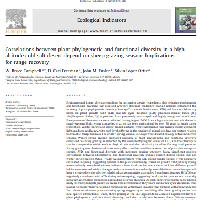Resumen
-
Environmental impact alters assemblages by increasing species relatedness, thus reducing phylogenetic and functional diversity. We assessed whether different controlled grazing regimes influenced the recovery of plant phylogenetic diversity (Average Taxonomic Distinctness, ATD) and functional diversity based on plant growth habit (GH) and life cycle duration (LCD) [Shannon-Weiner Index (H’), ln(Simpson’s Index, D)] in pastures from previously unmanaged and highly overgrazed conditions. Plant presence/absence data were collected during August 2006 from a high altitude cold salt desert in
south-western Utah, where controlled grazing has been maintained for over 70 years to study range restoration. Winter-spring and spring grazed pastures were examined at four grazing levels: ungrazed, light, medium, and heavy, with each level differing in the number of animal use days per hectare relative to available forage biomass. For winter-spring, animal use days were divided equally between the two seasons. Winter-spring grazing promoted recovery of plant phylogenetic and functional diversity compared to spring grazing as reflected by the consistently higher values of ATD, and the stability of species composition within each ecological trait and their similarity to values for ungrazed pastures.
Spring grazing was detrimental to recovery efforts and resulted in the reduction of palatable non-grass species, ATD, and functional diversity with increased grazing intensity. Many significant positive correlations between phylogenetic and functional diversity indices existed during spring, but not
winter-spring grazing. While H’(GH) was uncorrelated with ATD during winter-spring, it was positively correlated in spring, suggesting species in the plant community (based on growth habit) during spring were randomly assembled without influence from local species interactions, and that different growth
habits are conserved within lineages so that communities randomly assembled from more lineages will have a greater diversity of growth habits than communities assembled from fewer lineages. H’(LCD) was negatively correlated with ATD during winter-spring, suggesting local species interactions naturally influence assemblage composition regarding life cycle duration. As such, species within the same lineage likely interact (compete) more for scarce resources because they share similar life cycle durations, thus leading to greater trait variation in communities with fewer lineages than in those with many lineages. Yet, this correlation was positive during spring, suggesting an overriding effect from grazing rather than local species interactions. Hence, sheep grazing at the DER appears to be a season-dependent driver of plant phylogenetic and functional diversity, and the correlations between them. We recommend Average Taxonomic Distinctness and functional diversity based on growth habit and life cycle duration be considered as significant developments in the construction of practical rapid assessment tools for biomonitoring and feedback regarding grazing impacts in similar ecosystems.
